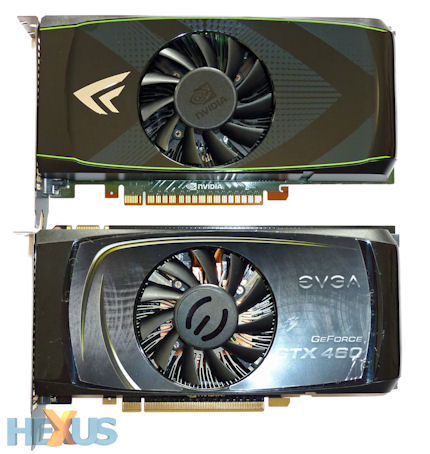Stack it up, Sandhu
| Graphics cards | NVIDIA GeForce GTX 460 768MB | NVIDIA GeForce GTS 450 1,024MB | AMD Radeon HD 5770 1,024MB | ATI Radeon HD 5750 1,024MB | ATI Radeon HD 5670 1,024MB |
|---|---|---|---|---|---|
| Die size | 1.95bn | 1.17bn | 1.04bn | 1.04bn | 0.63bn |
| Manufacturing process | TSMC, 40nm | TSMC, 40nm | TSMC, 40nm | TSMC, 40nm | TSMC, 40nm |
| General clock | 675MHz | 783MHz | 850MHz | 700MHz | 775MHz |
| Shader clock | 1,350MHz | 1,566MHz | 850MHz | 700MHz | 775MHz |
| Memory clock (effective) | 3,600MHz | 3,608MHz | 4,800MHz | 4,600MHz | 4,000MHz |
| Memory interface and size | 192-bit, 768MB, GDDR5 | 128-bit, 1,024MB, GDDR5 | 128-bit,
1,024MB, GDDR5 |
128-bit,
1,024MB, GDDR5 |
128-bit,
1,024MB, GDDR5 |
| Memory bandwidth | 86.4GB/s |
57.7GB/s |
76.8GB/s |
73.6GB/s | 64GB/s |
| DirectX/ Shader Model | DX11, 5.0 | DX11, 5.0 | DX11, 5.0 | DX11, 5.0 | DX11, 5.0 |
| Shaders | 336 | 192 | 800 | 720 | 400 |
| Single-precision GFLOPS (single-issue) | 907.2 |
601.3 |
1,360 |
1,008 |
620 |
| Texturing | 56ppc
bilinear 28ppc FP16 |
32ppc
bilinear 16ppc FP16 |
40ppc
bilinear 20ppc FP16 |
36ppc
bilinear 18ppc FP16 |
20ppc
bilinear 10ppc FP16 |
| ROPs | 24 |
16 |
16 | 16 |
8 |
| GPixels/s throughput | 16.2 |
12.5 |
13.6 |
11.2 | 6.2 |
| GTexel/s bilinear | 37.8 |
25.1 |
34 |
25.2 |
15.5 |
| Multi-GPU | Two-way SLI | Two-way SLI | Four-way XFire | Four-way XFire | Four-way XFire |
| Connectors (native) | 2 x dual-link DVI Mini-HDMI | 2x
dual-link DVI Mini-HDMI |
2x
dual-link DVI HDMI, DisplayPort |
2x
dual-link DVI HDMI, DisplayPort, |
2x
dual-link DVI HDMI, DisplayPort, |
| Retail price | £130
($179) |
£99 ($129) |
£115 ($159) | £105 ($135) | £85 ($99) |
Analysis: GeForce GTS 450 1,024MB
NVIDIA appreciates that, in late 2010, GPUs intended to fill the $99-$129 price point need small dies and cheap memory. GTS 450's 1.17bn transistor-count is 40 per cent lower than the GTX 460's and is comparable to the Radeon HD 57x0 GPUs that have been around for nearly a whole year.
Taken as an on-paper competition, GTS 450 is comprehensively outpaced by the Radeon HD 5750 1,024MB in the shading and memory bandwidth stakes, and it's just able to keep in touch with respect to texturing capabilities. What's more, the maximum board power is almost 25 per cent higher than the Radeon's. NVIDIA's GPUs tend to perform better in gaming than the specifications would suggest, however, and this really needs to be the case if the GTS 450 is going to displace the HD 5750 as the best £100 graphics card.
We must remember that GeForce 4xx GPUs put a greater focus on geometry performance than on shading and texturing, so the analysis suggests that its performance will be largely game-dependent.
NVIDIA's partners will launch a reference-based model, shown above, or a custom card that's heavily pre-overclocked. The reference design is practically identical to a GeForce GTX 460's, and while this is a boon for the overclocking potential of the board - wait till you see the numbers - hopes of a single-slot GTS 450 1,024MB rest in the hands of partners.










